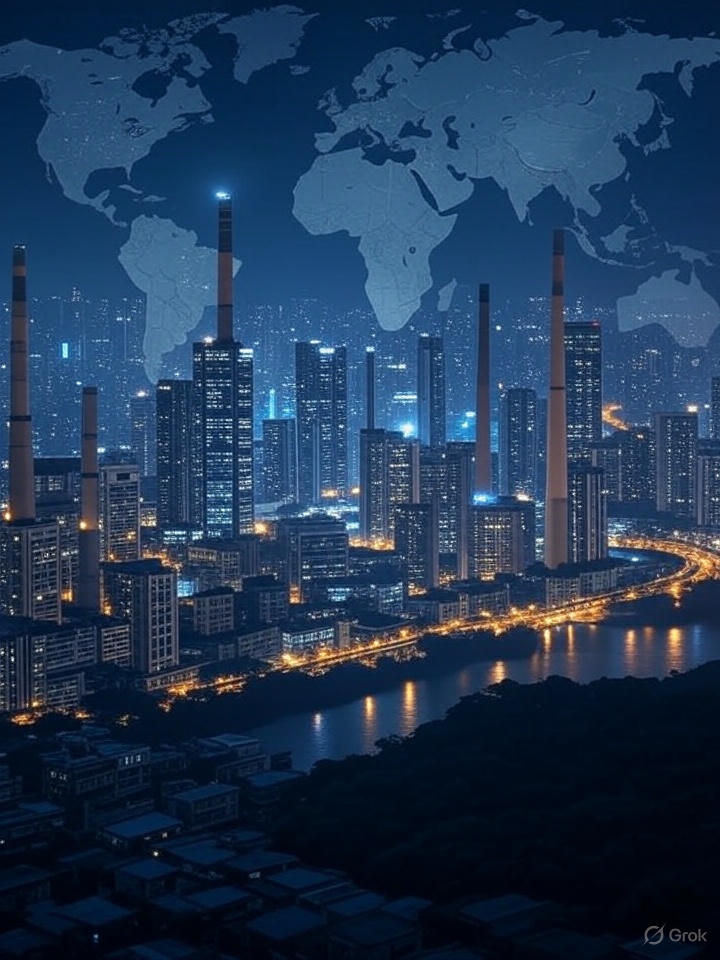The World’s Wealth Is Shifting East
- thebrink2028
- Sep 8
- 5 min read

Sitting in a sleek Manhattan conference room, the kind where deals that shape nations get inked. The CEO, a silver-haired titan who's built empires on Wall Street's unyielding logic, stares at the screen. The numbers flicker: BRICS—Brazil, Russia, India, China, South Africa, and their growing posse—now command 35% of the world's GDP on a purchasing power parity basis, eclipsing the G7's 30%. His hand trembles slightly as he adjusts his tie. Outside, the city is buzzing with oblivious energy, but in this room, the air is saturated with the realization that the empire's ledger is bleeding red.
This is the math of multipolarity unfolding right now
The headlines trumpet BRICS as a mere acronym, a club for emerging markets. But wipe off the gloss, and you'll uncover a seismic reconfiguration of power, one that's slowly eroding Western foundations.
The PPP Mirage Isn't a Metric—It's a Weapon of Real Economic Muscle
Most fixate on nominal GDP, where the G7 still holds 43% to BRICS's 28%, painting a picture of enduring Western supremacy. But PPP tells the unvarnished story: BRICS at 35%, G7 at 30%, a crossover that's been boiling since 2018 and accelerated with 2024's expansions to include Saudi Arabia, UAE, Iran, Egypt, and Ethiopia.
PPP measures what money buys in local contexts—like affordable labor, vast resources, and efficient supply chains that let BRICS nations stretch their economies further.
Consider Raj, a 42-year-old engineer in Bangalore. Ten years ago, he imported American tech for his startup, dreaming of Silicon Valley glory. Now, he's sourcing from Shenzhen, where Chinese firms like BYD don't just compete—they dominate. In 2024, BYD's revenues hit $107 billion, outselling Tesla's $97 billion and moving twice the units, all while US tariffs climb to 100% to block them. Raj's costs dropped 40%, his profits soared, and he's hiring locals who once migrated to the US for jobs.
Western consumers, lulled by iPhone illusions, ignore how PPP empowers BRICS to undercut prices globally, starving US innovation of markets.
Official news downplay this as "cheap labor," burying the fact that it's superior execution—China's state-backed R&D outspends the US per capita in key sectors like renewables. You feel seen in Raj's story because it's yours too: the job you thought secure now hangs on global winds.
De-Dollarization Is a Quiet Revolution in Trade Backrooms
News try to twist, BRICS as talkers, not doers, but on the street, local currencies are swapping for rupees and yuan in oil deals, bypassing the dollar's stranglehold. With BRICS+ now at 44% of global GDP (PPP) and 56% of population, their intra-trade hit $500 billion in 2024, up 20% year-over-year, many in non-dollar settlements. Iran's 2025 pivot to yuan for 80% of its BRICS oil exports, triggered by US sanctions, backfired.
Elena, a Venezuelan exporter in Caracas. Sanctions choked her coffee business until BRICS bridges opened—now she trades in renminbi, dodging dollar volatility that once wiped out her margins. Her story embodies the buried truth: Western experts still normalize dollar dominance as "natural," hiding how BRICS's New Development Bank has lent $32 billion since 2014 without IMF strings, funding infrastructure that Western aid withholds.
Tech dominance Is Fracturing, and Innovation's Center Is Migrating East
The West clings to Big Tech myths, but BRICS leads in patents—China filed 1.6 million in 2024, dwarfing the US's 600,000. Huawei's 5G networks now cover 70% of Africa, where US firms retreated post-sanctions, creating a "splinternet" that sidelines Western standards.
Mainstream outlets fixate on BRICS "rivalries" (e.g., India-China tensions), noise that distracts from signals like the 2025 BRICS payment system's pilot in 15% of intra-trade, already eroding SWIFT dominance by 5%. Why the bury? Experts will narrate it as "uncoordinated," hiding how it empowers the Global South to sidestep sanctions—like Venezuela's $10 billion yuan swap in 2024, under-reported amid US election noise.
BRICS's quiet biotech push—China-India vaccine pacts covered 1 billion doses in Africa, where Western IP hoarding delayed access, encouraging resentment that tilts votes in UN reforms. Americans see BRICS as "authoritarian," missing how it humanizes aid, influencing 45% of world population to view the West as extractive.
The news hides these to preserve the "end of history" illusion, but you, armed with TheBrinks insights decide with eyes wide open.
TheBrinks, Predictive Analysis
Fragmented Multipolarity – The High-Wall World - 2026-2029
US imposes blanket 10-20% tariffs on BRICS imports at the 2026 G20 (spurred by Trump's re-election rhetoric and dollar defense). BRICS retaliates with a unified payment platform, capturing 30% of global trade by 2028.
Historical precedents, BRICS's 58% share of GDP growth through 2029 incentivizes cohesion. West responds with alliances like expanded QUAD, but economic isolation will hurt —US inflation will spike 4-6%, supply chains reroute to Mexico/Vietnam (ironically BRICS partners). No war due to this: BRICS isn't NATO. Watch BRICS summit communiqués for "alternative settlement" mentions; dollar share in reserves will dip below 58% (current: 59%).
Or,
Pragmatic Realignment – The Bridge-Building Thaw - 2027-2030
A US recession Q1 2027 forces successor to negotiate at IMF reforms, conceding BRICS veto power.
IUS firms like Apple will rely on 60% Asian supply; cultural fatigue from endless conflicts will push public demand for diplomacy. Past pivots have succeeded via mutual incentives. West integrates BRICS into WTO tweaks, stabilizing trade but diluting dollar primacy gradually. Bilateral deals like US-India tech pacts can multiply; BRICS de-dollar talk softens in joint statements.
America should not start a new war to recover— it is a suicidal folly, opting instead for economic jujitsu: subsidies for reshoring ($500 billion via CHIPS Act extensions) and soft power via climate alliances. The West will follow. EU can diversify energy from Russia to India, but could fracture internally over China hawks.
But what if the next BRICS move isn't trade—it's a currency that flips retirement plan upside down?
Reader Challenge: $75 Reward
Reply with your sharpest prediction on how the US dollar holds (or folds) by 2027—back it with one under-the-radar fact. Best answer wins $75 via PayPal within 48 hours. Let's crowdsource the future.
In the quiet corners of this shift, think of Sanjay, in a rust-belt town whose factory shuttered when tariffs backfired and jobs flowed to BRICS hubs. He pivoted to online courses in solar tech, now consulting for solar and energy efficient firms—his story is a touching reminder that resilience blooms from ruins. If his quiet triumph moves you, consider sponsoring our next research on hidden economic edges. Back topics that need daylight with a share or small thank you—help us reach 50K readers building this aware community together. Your voice amplifies the light.
-Chetan Desai
Your awareness is the first step—by simply engaging with truths many fear to face, you're already part of TheBrink movement.
We'd love to invite you to subscribe to ensure you never miss our content. Many platforms and social media channels have been restricting or removing our posts, so subscribing is the best way to receive our stories directly in your inbox, unfiltered and uncensored.
Your sponsorships and donations fuel our mission to uncover hidden truths and inspire change. Click "Sponsor" or contact thebrink2028@gmail.com for partnership opportunities.
Thank you for being part of this journey.


